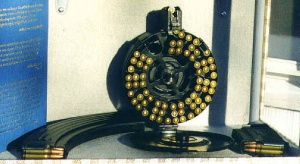Drum magazine
A drum magazine is a type of magazine that is cylindrical in shape, similar to a drum. In a drum magazine, rounds are stored in a spiral around the center of the magazine. The advantage over traditional box-shaped magazines is that a drum magazine can carry much more ammunition, often twice that of a box magazine, such as the 71-round drum for the Russian PPSh-41 submachine gun without making it too big to be impractical to carry. The downside to drum magazines is that they are more prone to jamming and increase the overall weight of the weapon in which they are being used, making it harder for most to sustain accurate fire. The iconic 1930s-era "Tommy gun" uses distinctive drum magazines. A current example is the 90 rounder and the Beta C-Mag. Most firearms have standard box magazines, but a few, like the M31 Suomi are less common with boxes. The M-31 was also more reliable with drum magazines than with boxes. There are also double drums presently available - where normal magazines put rounds in two rows, two drums each have one row, which combine into one row before entering the receiver.
The drums of aircraft cannon such as the M61 Vulcan and GAU-8 Avenger resemble drum magazines for small arms, but function in a different manner. That is, the rounds are stored nose-facing-in, and are kept under positive control by partitions running the length of the drum, and are driven forward by a helical auger. This makes their operation very reliable, even when operated at rates of fire of 6000 or more shots per minute (SPM). (In the context of Gatling-type cannon, revolutions per minute and rounds per minute would easily be confused, hence SPM)
[edit] Other weapons
[edit] See also

This article or section is just a stub, and could use more information to fill in the missing bits.
You (yes, you!) can help Gunsopedia and our users by using your own knowledge to expand it
